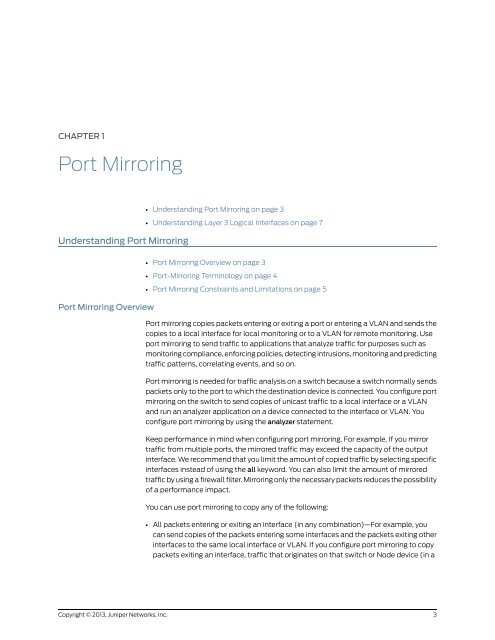Services on the QFX Series - Juniper.net
Services on the QFX Series - Juniper.net
Services on the QFX Series - Juniper.net
Create successful ePaper yourself
Turn your PDF publications into a flip-book with our unique Google optimized e-Paper software.
CHAPTER 1<br />
Port Mirroring<br />
Understanding Port Mirroring<br />
• Understanding Port Mirroring <strong>on</strong> page 3<br />
• Understanding Layer 3 Logical Interfaces <strong>on</strong> page 7<br />
• Port Mirroring Overview <strong>on</strong> page 3<br />
• Port-Mirroring Terminology <strong>on</strong> page 4<br />
• Port Mirroring C<strong>on</strong>straints and Limitati<strong>on</strong>s <strong>on</strong> page 5<br />
Port Mirroring Overview<br />
Port mirroring copies packets entering or exiting a port or entering a VLAN and sends <strong>the</strong><br />
copies to a local interface for local m<strong>on</strong>itoring or to a VLAN for remote m<strong>on</strong>itoring. Use<br />
port mirroring to send traffic to applicati<strong>on</strong>s that analyze traffic for purposes such as<br />
m<strong>on</strong>itoring compliance, enforcing policies, detecting intrusi<strong>on</strong>s, m<strong>on</strong>itoring and predicting<br />
traffic patterns, correlating events, and so <strong>on</strong>.<br />
Port mirroring is needed for traffic analysis <strong>on</strong> a switch because a switch normally sends<br />
packets <strong>on</strong>ly to <strong>the</strong> port to which <strong>the</strong> destinati<strong>on</strong> device is c<strong>on</strong>nected. You c<strong>on</strong>figure port<br />
mirroring <strong>on</strong> <strong>the</strong> switch to send copies of unicast traffic to a local interface or a VLAN<br />
and run an analyzer applicati<strong>on</strong> <strong>on</strong> a device c<strong>on</strong>nected to <strong>the</strong> interface or VLAN. You<br />
c<strong>on</strong>figure port mirroring by using <strong>the</strong> analyzer statement.<br />
Keep performance in mind when c<strong>on</strong>figuring port mirroring. For example, If you mirror<br />
traffic from multiple ports, <strong>the</strong> mirrored traffic may exceed <strong>the</strong> capacity of <strong>the</strong> output<br />
interface. We recommend that you limit <strong>the</strong> amount of copied traffic by selecting specific<br />
interfaces instead of using <strong>the</strong> all keyword. You can also limit <strong>the</strong> amount of mirrored<br />
traffic by using a firewall filter. Mirroring <strong>on</strong>ly <strong>the</strong> necessary packets reduces <strong>the</strong> possibility<br />
of a performance impact.<br />
You can use port mirroring to copy any of <strong>the</strong> following:<br />
• All packets entering or exiting an interface (in any combinati<strong>on</strong>)—For example, you<br />
can send copies of <strong>the</strong> packets entering some interfaces and <strong>the</strong> packets exiting o<strong>the</strong>r<br />
interfaces to <strong>the</strong> same local interface or VLAN. If you c<strong>on</strong>figure port mirroring to copy<br />
packets exiting an interface, traffic that originates <strong>on</strong> that switch or Node device (in a<br />
Copyright © 2013, <strong>Juniper</strong> Networks, Inc.<br />
3
















